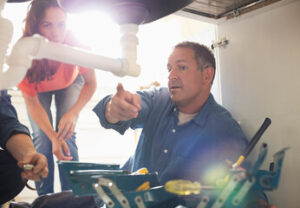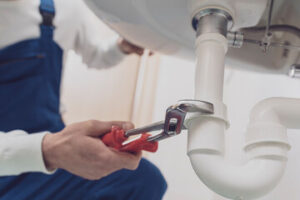Westfield Plumbing is a system of pipes and fixtures that bring water into buildings and carry waste water out. Plumbers install, repair, and maintain these systems.

A plumber’s work is physically demanding and requires a strong work ethic. They often work evenings and weekends. They may also be on-call for emergency situations.
Drain pipes are a key part of your home’s plumbing system. They transport wastewater and solid waste away from sinks, tubs, and showers to the sewer or septic tank. There are several different types of drain pipes, each designed to handle specific waste and water types. Understanding how they differ and how to distinguish them is crucial for proper installation and maintenance.
One of the most common types of drain pipe is a PVC (polyvinyl chloride) line. This type of pipe is easy to clean and is resistant to corrosion. PVC is also highly affordable and durable, making it a popular choice for residential use. However, PVC does have some drawbacks. While it is environmentally friendly, it cannot withstand high temperatures and is not as durable as other piping materials.
Another type of drain pipe is a metal drainpipe, which is typically made from stainless steel or galvanized steel. These pipes are able to withstand higher temperatures and are more durable than plastic pipes. Metal drainpipes are also less susceptible to rusting than other piping materials. However, metal drainpipes are usually more expensive than other types of piping.
There are also a variety of specialty drainpipes, such as floor drains and French drains. These pipes are used to facilitate the drainage of standing water in yards and other outdoor spaces. They are typically installed in a trench and filled with gravel or other porous material. The gravel serves to help prevent erosion and sand from washing into the trench.
Lastly, there are sanitary sewer lines, which are the largest drain pipes in your home. These pipes are used to transport sewage and waste from toilets, showers, and sinks to the septic tank or municipal sewer system. In order for these pipes to work properly, they must be in good condition.
While a drain pipe and a sewer pipe both serve the same purpose, they are very different in terms of size and how they are used. Taking the time to understand the differences between these two pipes can ensure that your plumbing is working correctly and safely. It can also help you make an informed decision about a potential plumbing project at home.
Vent Pipes
The plumbing system is designed to remove water and waste efficiently. It relies on both the drainage and vent pipes to do its job well. Drainage pipes carry wastewater out of your home to the city sewer or septic tank. Vent pipes ensure that fresh air gets into the drainage pipes to prevent a vacuum that can cause slow or no drainage. Understanding how these two systems work together can help you diagnose and resolve common plumbing issues.
What Is a Plumbing Vent Pipe?
A plumbing vent pipe is a pipe that runs from your drain line to the roof of your house. They also serve to ventilate the air in your plumbing system, helping it to function properly. Plumbing vents can be made of a variety of materials and come in different shapes and sizes. There are several different types of ventilation options available, including true vent pipes, ductile iron pipe, galvanized steel and PVC. The best option for your home depends on the size and layout of your house, local building codes and other factors.
Generally, every fixture has a trap seal (also called a “p-trap”) that is filled with water. This seal keeps sewer gas from entering your home through a drain. However, the pressure of your plumbing system can fluctuate over time, and if that pressure is great enough, the trap can lose its water seal. If that happens, the p-trap becomes nothing more than an empty piece of plastic and allows sewer gas to enter your home. A plumbing vent introduces air into your drainage system, breaking the siphon and preventing the loss of the crucial trap seal.
Another reason for venting is that it lets in fresh air, which helps prevent condensation in your pipes. This can lead to mold, mildew and other nasty growths that can affect your health. Venting also prevents the buildup of ice in your pipes, which can lead to blocked or frozen drains.
Unfortunately, a lot of things can go wrong with your vents. Because they are exposed to the elements, they can become clogged with leaves, branches, snow, rodents and other debris. Blocked vents create negative pressure in your plumbing system, which causes the drains to glug or stop working completely. Some of the most common signs of a blocked vent include gurgling sounds coming from your drains or sewage odors in your home.
Fixtures
In the context of home and commercial plumbing, fixtures are the receptacles that receive and discharge water and water-carried waste. Some of the most common types of plumbing fixtures include sinks, bathtubs and showers, toilets, and drain stoppers. These devices serve a variety of purposes, including providing water for drinking, washing, and bathing. They also provide a means of disposing of human waste and wastewater, which is then collected by sewage systems or sewers.
Unlike pipes, which are buried in the walls and floors of a building, fixtures are usually mounted on the walls or on stands for easy accessibility for repair and maintenance. They are available in a wide variety of shapes, sizes, and styles to meet individual preferences and needs. They can be adorned with a variety of finishes, and they come in different colors and materials to suit the design of the space.
Fixtures are also used in manufacturing, where they help maintain accuracy and ensure consistent production. They help reduce setup times, increase efficiency, and improve the quality of finished products. They are commonly used in the machining industry, but they can be found in other industries that require drilling, grinding, cutting, and assembly.
While jigs and fixtures can be costly to design, they can lead to significant cost savings for manufacturers in the long run. They can also save time by eliminating the need for manual adjustments to machine parts during production, which can result in errors and rework. By securely positioning components, they also minimize mistakes and accidents, making them a crucial component of any manufacturing process.
With the advent of computerized machining and automation, fixture design has become increasingly sophisticated. Using software solutions like fixturemate, designers can quickly and easily create custom fixtures for specific workpieces and manufacturing processes. This digital transformation has made it possible to streamline the design process and make fixture-making more accessible, even for those who are new to CAD. This has paved the way for dramatic reductions in manufacturing costs and increased productivity, particularly in industries like automotive and aerospace.
Water Heaters
A water heater is a large metal cylinder that holds hot water at the desired temperature. It is usually located in a garage, basement or laundry room and uses either gas or electricity to heat the water. Electricity-powered water heaters use a heating element to create the hot water, while gas-powered water heaters have a flame underneath the tank that warms the water. Water heaters can also be powered by solar, wind or geothermal energy.
A cold water inlet on the bottom of a tank feeds cold water into the inside base, where it’s heated by a burner or heating element. As the water heats up, it rises to the top of the tank where it exits through a hot water outlet tube. Water temperatures are controlled by a thermostat, which is adjustable. The recommended water temperature setting is between 120 and 140 degrees Fahrenheit. Higher temperatures create a higher risk of scalding.
In some homes, electric point-of-use water heaters with low power heating elements are installed in sink cabinets and used for hand washing only. These units do not have a bulky storage tank and are more energy efficient. They are also a good choice for retrofitting existing buildings where a high-capacity tank is too expensive or impractical to install.
During normal operation, electrical current runs through a 220-volt circuit and past two heating elements inside the tank that are powered by a thermostat. The thermostat keeps the heating elements turned on until it senses that the water temperature has fallen below the setpoint. When this happens, the thermostat shuts off the heating elements to prevent overheating.
Most tanks have a temperature and pressure relief valve on the side or at the top and a drain valve on the bottom. The valves are not normally used, but they serve as a safety precaution in case the tank is damaged or has a leak. They also allow you to drain the tank occasionally for maintenance and to remove sediment from the bottom of the tank.



